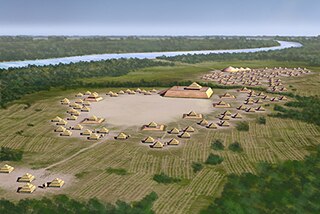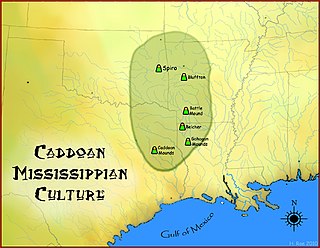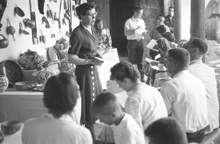
Somervell County is a county on the Edwards Plateau in the U.S. state of Texas. As of the 2020 census, its population was 9,205. Its county seat is Glen Rose. The county is named for Alexander Somervell, secretary of war for the Republic of Texas.

Spiro Mounds is an Indigenous archaeological site located in present-day eastern Oklahoma. The site was built by people from the Arkansas Valley Caddoan culture. that remains from an American Indian culture that was part of the major northern Caddoan Mississippian culture. The 80-acre site is located within a floodplain on the southern side of the Arkansas River. The modern town of Spiro developed approximately seven miles to the south.

The French colonization of Texas began with the establishment of a fort in present-day southeastern Texas. Fort Saint Louis was established in 1685 near Arenosa Creek and Matagorda Bay by explorer Robert Cavelier de La Salle. He intended to found the colony at the mouth of the Mississippi River, but inaccurate maps and navigational errors caused his ships to anchor instead 400 miles (640 km) to the west, off the coast of Texas. The colony survived until 1688. The present-day town of Inez is near the fort's site. The colony faced numerous difficulties during its brief existence, including Native American raids, epidemics, and harsh conditions. From that base, La Salle led several expeditions to find the Mississippi River. These did not succeed, but La Salle did explore much of the Rio Grande and parts of east Texas.

Town Creek Indian Mound is a prehistoric Native American archaeological site located near present-day Mount Gilead, Montgomery County, North Carolina, in the United States. The site, whose main features are a platform mound with a surrounding village and wooden defensive palisade, was built by the Pee Dee, a South Appalachian Mississippian culture people that developed in the region as early as 980 CE. They thrived in the Pee Dee River region of North and South Carolina during the Pre-Columbian era. The Town Creek site was an important ceremonial site occupied from about 1150—1400 CE. It was abandoned for unknown reasons. It is the only ceremonial mound and village center of the Pee Dee located within North Carolina.
Mark Raymond Harrington was curator of archaeology at the Southwest Museum from 1928 to 1964 and discoverer of ancient Pueblo structures near Overton, Nevada, and Little Lake, California.

The Belcher Mound Site (16CD13) is an archaeological site in Caddo Parish, Louisiana. It is located in the Red River Valley 20 miles north of Shreveport and about one-half mile east of the town of Belcher, Louisiana. It was excavated by Clarence H. Webb from 1959 to 1969. The site gives its name to a local phase of the Caddoan Mississippian culture, the Belcher Phase, which radiocarbon dates suggest lasted from 1400 to 1600 CE.
The Trinchera Cave Archeological District (5LA9555) is an archaeological site in Las Animas County, Colorado with artifacts primarily dating from 1000 BC to AD 1749, although there were some Archaic period artifacts found. The site was added to the National Register of Historic Places in 2001 and is located on State Trust Lands.

Caddo Mounds State Historic Site (41CE19) is an archaeological site in Weeping Mary, Texas. This Caddoan Mississippian culture site is composed of a village and ceremonial center that features two earthwork platform mounds and one burial mound. Located on a precontact Native American trail later named by the Spanish as El Camino Real de los Tejas, the settlement developed hundreds of years before the arrival of Europeans to the region. Archaeologists believe the site was created in approximately 800 CE, with most major construction taking place between 1100 and 1300 CE.

Colha, Belize is a Maya archaeological site located in northern portion of the country, about 52 km. north of Belize City, near the town of Orange Walk. The site is one of the earliest in the Maya region and remains important to the archaeological record of the Maya culture well into the Postclassic Period. According to Palma Buttles, “Archaeological evidence from Colha allows for the interpretation occupation from the Early Preceramic (3400-1900B.C.) to Middle Postclassic with population peaks occurring in the Late Preclassic and again in the Late Classic ”. These peaks in population are directly related to the presence of stone tool workshops at the site. Colha's proximity to an important source of high quality chert that is found in the Cenozoic limestone of the region and well traveled trade routes was utilized by the inhabitants to develop a niche in the Maya trade market that may have extended to the Greater Antilles. During the Late Preclassic and Late Classic periods, Colha served as a primary supplier of worked stone tools for the region. It has been estimated that the 36 workshops at Colha produced nearly 4 million chert and obsidian tools and eccentrics that were dispersed throughout Mesoamerica during the Maya era. This made it an important player in the trade of essential good throughout the area.
The Apishapa culture, or Apishapa Phase, a prehistoric culture from 1000 to 1400, was named based upon an archaeological site in the Lower Apishapa canyon in Colorado. The Apishapa River, a tributary of the Arkansas River, formed the Apishapa canyon. In 1976, there were 68 Apishapa sites on the Chaquaqua Plateau in southeastern Colorado.
Edward Baker Jelks was an American archaeologist trained as a prehistorian yet known for his contributions to historical archaeology and leadership roles in multiple anthropological organizations, including the Society for Historical Archaeology and the Society of Professional Archaeologists.
Madeline Kneberg Lewis (1903–1996) was an American archaeologist and professor of anthropology at the University of Tennessee. She is most famous for her work on excavations in the Tennessee Valley, beginning in the 1930s. She was instrumental in establishing the anthropology department at the University of Tennessee as well as the Frank H. McClung Museum. She was the first female full professor at Tennessee outside of home economics and among the first prominent female archaeologists in the United States.

The Gault archaeological site is an extensive, multicomponent site located in Florence, Texas, United States on the Williamson-Bell County line along Buttermilk Creek about 250 meters upstream from the Buttermilk Creek complex. It bears evidence of almost continuous human occupation, starting at least 16,000 years ago—making it one of the few archaeological sites in the Americas at which compelling evidence has been found for human occupation dating to before the appearance of the Clovis culture. Archaeological material covers about 16 hectares with a depth of up to 3 meters in places. About 30 incised stones from the Clovis period engraved with geometric patterns were found there as well as others from periods up to the Early Archaic. Incised bone was also found.

Katharine Bartlett (1907–2001) was an American physical anthropologist who worked from 1930 to 1952 as the first curator of the Museum of Northern Arizona, cataloging and organizing the museum's holdings, and then as the museum's librarian until 1974 and archivist until 1981. She participated in a survey of the Navajo Nation's reservation in the Little Colorado River basin and established the cataloging system used by the Glen Canyon Archaeological Project. She was a Fellow of the American Association for the Advancement of Science, a Fellow of the American Anthropological Association and a Fellow of the Society of American Archaeology, as well as the first Fellow of the MNA. Honored in an exhibit of the Smithsonian Institution in 1986 and a recipient of the 1991 Sharlot Hall Award for her contributions to Arizona history, she was posthumously inducted into the Arizona Women's Hall of Fame in 2008.
María del Pilar Luna Erreguerena was a Mexican underwater archaeologist, pioneer in the field of archaeology, who founded the Division of Underwater Archaeology of the National Institute of Anthropology and History (INAH). She was awarded her undergraduate degree by the National School of Anthropology and History and the National Autonomous University of Mexico (UNAM), from which she then obtained her master's degree in Anthropological Sciences.
Whitney Battle-Baptiste is an American historical archaeologist of African and Cherokee descent. She is an associate professor at the University of Massachusetts Amherst and director of the W.E.B. Du Bois Center at the University. Battle-Baptiste's research focuses on "how the intersection of race, gender, class, and sexuality look through an archaeological lens".

Kathleen K. Gilmore was an American archaeologist and specialist on Spanish colonial archaeology. She was the first archaeologist to prove the location of Fort St. Louis, established by the French explorer, René-Robert Cavelier, Sieur de La Salle. She received the J. C. Harrington Award of Society for Historical Archaeology in 1995, the first woman ever honored by the society.

William D. Lipe, also known as Bill Lipe, is an archaeologist known for his work in the American Southwest and his Conservation Model. Lipe has contributed to Cultural Resource Management (CRM) and public archaeology. In addition to this, he has done work with the Glen Canyon Project, the Dolores Archaeological Program, and the Crow Canyon Archaeological Center.

Mildred Mott Wedel was an American scholar of Great Plains archaeology and ethnohistory. She was one of the first professionally trained female archaeologists and was distinguished in her field. Many of her publications were about the Siouan people, and wrote several important articles on French exploration in the Central and Southern Plains.











